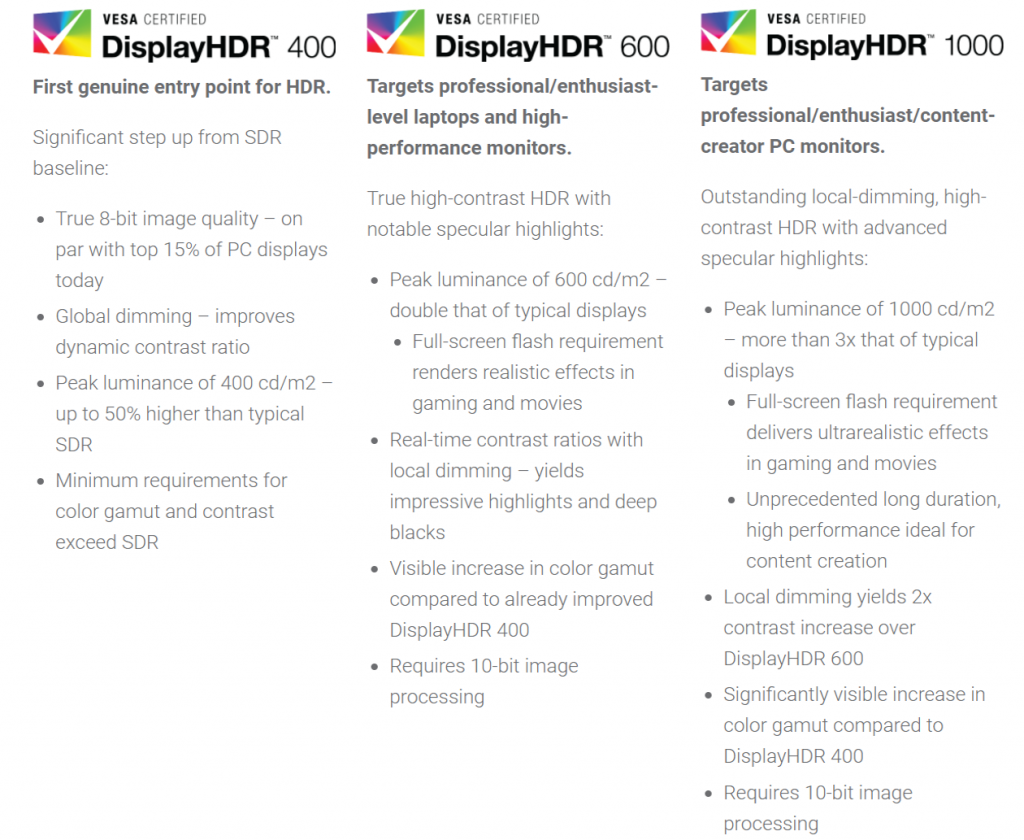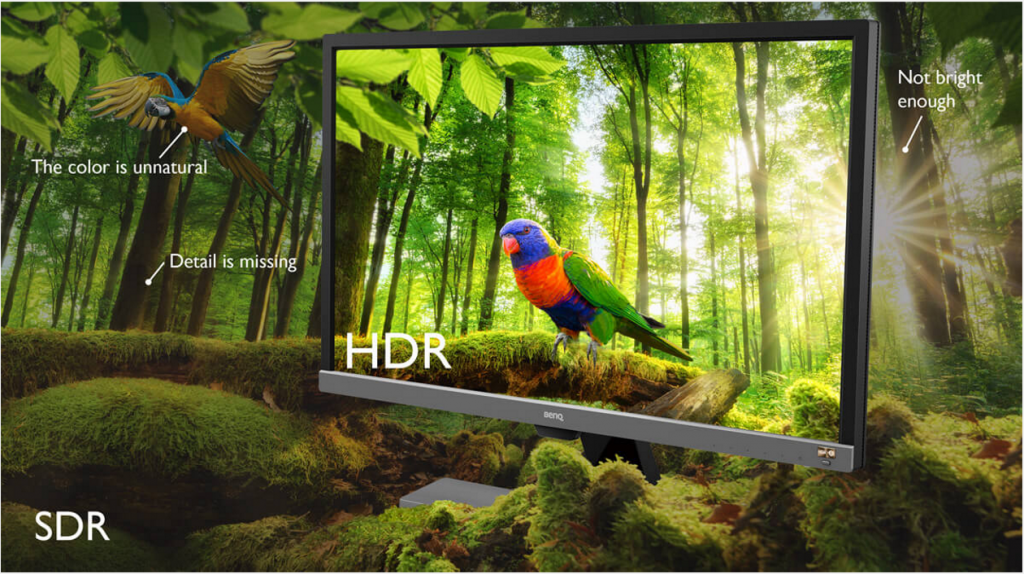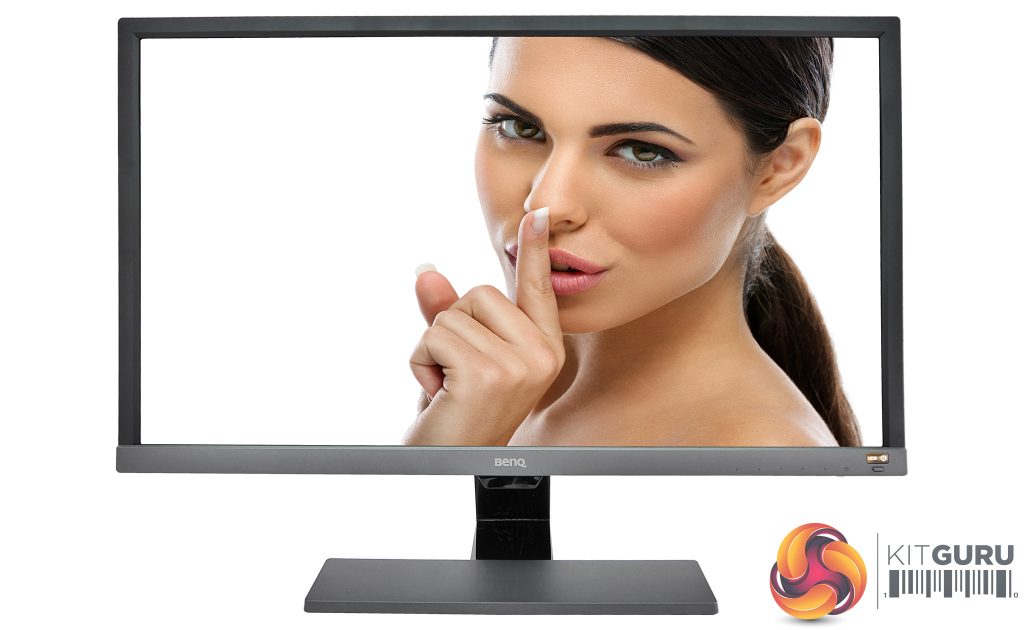BenQ EL2870U Image Quality – HDR
The HDR (High Dynamic Range) landscape – especially on the PC rather than AV side of things – is a little like the Wild West at the moment. It’s a lawless place where many manufacturers and standards bodies play by their own rules. Although HDR standards are fairly well defined for AV content and televisions, with the “Ultra HD Premium” certification by the UHD Alliance being a gold-standard yardstick, monitors are a little more tricky when it comes to their ability to properly display high dynamic range.
Unlike what many people seem to be assuming, HDR isn’t just about material being brighter. The two main elements of real HDR are expanded dynamic range, meaning deeper blacks and brighter highlights with more detail at both ends of the spectrum; and expanded colour space, meaning a greater range and intensity of visible colours. Both elements are meant to make an HDR image look more like ‘real life’ than the same image in SDR (Standard Dynamic Range) – and can certainly do so, if properly mastered and displayed.
The most recognisable monitor HDR standards are set by the VESA body, which has three different classifications: DisplayHDR400, DisplayHDR 600, and DisplayHDR 1000. While the latter two at least attempt to incorporate the essential elements by demanding low black levels, increased luminance and DCI-P3 colour coverage over the sRGB colour space used by SDR, DisplayHDR 400 only demands 400 nits of brightness, a contrast ratio of 955:1, and a colour space of 95% of BT.709 (equivalent to sRGB). Yes, subtract around 50-100 nits of brightness and that’s pretty much the exact spec of every good high-end SDR monitor from the past few years. Just to be clear, it in no way matches any of the HDR requirements, and watching HDR content on a DisplayHDR 400-certified monitor is not going to show you what all the (justified) fuss is about.
But unfortunately, that’s not even as bad as HDR gets. Many manufacturers of budget monitors (and a few TVs, for that matter) are adding HDR compatibility to their displays. This does not mean these displays can actually give you a proper HDR experience, only that they can accept and process the HDR metadata that an HDR source carries. And then try to show it. Badly. In what is essentially SDR. To give an extreme analogy, think of it like a TV that can play a colour movie (source), but only show it to the viewer in black and white; obviously, you’ll be missing out on the full experience and it most certainly won’t look like the director intended.
Naturally not every monitor that lacks VESA certification will be sporting ‘fake’ HDR credentials, but limited 300 nits brightness and colour specs aside, the best indicator that the BenQ EL2870U won’t be giving you the full high dynamic range experience is that its HDR presets are available all the time, even with SDR sources. SDR to HDR conversion aside, actual HDR should not have presets that are accessible when the source is SDR; it should be automatically recognised based on HDR metadata and switch to the correct mode without any user intervention.
Mind you, when you do pop on an HDR game or movie, the EL2870U will dutifully pop up a message indicating an HDR source has been recognised, and grey out all OSD image presets except for HDR and HDR Cinema. It will then show you that glorious content in SDR with a limited colour space, maximum brightness of 258 nits (at least on our sample, the official spec claims 300 nits), and raised blacks that tend towards 0.7 when there are highlights displayed simultaneously; thus lacking the contrast, dynamism, vibrancy and subtlety that make HDR worthwhile.
To be fair, BenQ is hardly alone in this kind of Tomfoolery, with the most recent example on KitGuru being the Dell U2518D featuring “Dell HDR”. And it’s also worth pointing out that, when all’s said and done, we would rather that a monitor have the ability to process HDR than not. However, we do feel for any buyers who purchase a display advertised with HDR capabilities but are disappointed with the mediocre results due to these kind of obfuscations.
BenQ EL2870U Gaming
Since our test system uses an Nvidia card and we could not get hold of a GPU from the Red Team in time for this review, we did not test the FreeSync features of the EL2870U. However, we suspect one of the reasons BenQ has positioned this particular monitor as a ‘casual’ gaming display is that it tops out at a maximum refresh of 60Hz and doesn’t support LFC (Low Framerate Compensation) below its somewhat limited 40-60Hz FreeSync range. This means that once your game drops below 40fps, which it is likely to frequently do at the EL2870U’s native UHD resolution, you essentially loose the advantage of variable refresh.
However, for less graphically intensive titles that can maintain higher framerates, and for ‘slower’ games like strategy or RPG titles, this monitor holds up well. As mentioned it displays every bit of dark detail on the right preset (albeit at the cost of black depth), and its 1ms response time and the quick pixel response inherent to most modern TN panels ensures ghosting is kept to a minimum while dark smearing is virtually nonexistent.
 KitGuru KitGuru.net – Tech News | Hardware News | Hardware Reviews | IOS | Mobile | Gaming | Graphics Cards
KitGuru KitGuru.net – Tech News | Hardware News | Hardware Reviews | IOS | Mobile | Gaming | Graphics Cards





